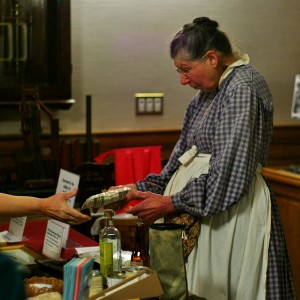Women ran businesses at home, supplied front lines during Civil War
By Kyle Carrozza, Staff Writer, The Times
-

Dr. Florence K. Williams presents recreated artifacts to attendees. Items included slippers, a brandy bottle, faurina packets, and lemonade mix, which used the same recipe still used today.
COATESVILLE – While men are very often the ones recognized with songs and medals during times of war, women are the ones who take over duties while men are off fighting.
During her lecture Thursday night at the National Iron and Steel Heritage Museum, Dr. Florence K. Williams recounted the stories of Coatesville women during the Civil War.
Williams said that she originally set out to study the actions of women during the Civil War but found so much information through U.S. Census and newspaper reports from the time that she ended up focusing her efforts on women in Coatesville, particularly in 1862.
Many of the contributions came through women sending supplies from home to hospitals and the front lines during the war.
“What do we need to get to the soldiers, and how do we get it there?” Williams said that the women asked themselves.
Wealthy and poor alike sent items to soldiers, and each citizen’s donation was listed in newspapers. Donations ranged from clothing to food (including corn starch, dried beef, jam, and chocolate) to bedding to lint (used for absorbing blood during medical treatments), and reading material—Williams noted that even three month old newspapers gave soldiers something to occupy their time with.
Much of the aid was organized through church groups. The women of Coatesville eventually founded the Coatesville Ladies Aid Society in 1861. The society organized shipments to the front lines and always made sure to send one of their own to ensure the items reached their destination without getting caught up in government red tape.
Williams also gave a glimpse of the town that was able to provide that aid.
“The number of trades in this small community was quite extensive,” she said.
Williams said that, like much of its history, the city’s economy was based around iron and steel. However, the coal, brick, and lumber industries were also represented, and farms surrounded the city. In addition, over half the residents made livings as tradesmen. Samuel Greenwood, a wool mill owner who specialized in fine clothes, made uniforms during the war. In order to make many of the uniforms, he produced pieces of fabric that were then given to local women to sew together.
In addition to the businesses in the area, Coatesville, at the time had integrated common schools—that is, schools that girls and black students attended alongside white males.
Williams said that women took over many of their husbands jobs during the war. Martha F. Gordon became postmistress and was so loved by the community that when she was fired after the war, protests ensured she was reinstated and even received a raise.
Williams said that women running their husbands’ businesses and farms proved that they could do these jobs, giving them a sense of independence.
“We learning we could do those kinds of things,” she said.
The country’s dependence on women during times of war has been a recurring theme throughout history. Williams mentioned Rosie the Riveter as a World War II example of the nation’s need for women.
“The women come to the rescue. The guys can’t do without us,” she said.






